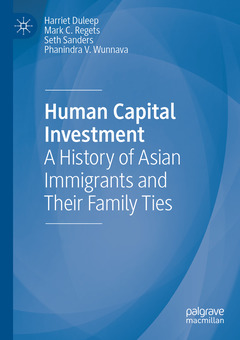Human Capital Investment, 1st ed. 2020 A History of Asian Immigrants and Their Family Ties
Auteurs : Duleep Harriet, Regets Mark C., Sanders Seth, Wunnava Phanindra V.

In 1965, a family-reunification policy for admitting immigrants to the United States replaced a system that chose immigrants based on their national origin. With this change, a 40-year hiatus in Asian immigration ended. Today, over three-quarters of US immigrants originate from Asia and Latin America. Two issues that dominate discussions of US immigration policy are the progress of post-reform immigrants and their contributions to the US economy.
This book focuses on the earnings and human capital investment of Asian immigrants to the US after 1965. In addition, it provides a primer on studying immigrant economic assimilation, by explaining economists? methodology to measure immigrant earnings growth and the challenges with this approach. The book also illustrates strategies to more fully use census data such as how to measure family income and how to use ?panel data? that is embedded in the census.
The book is a historical study as well as an extremely timely work from a policy angle. The passage of the 1965 Immigration and Nationality Act set the United States apart among economically developed countries due to the weight given to family unification. Based on analyses by economists?which suggest that the quality of immigrants to the US fell after the 1965 law?policymakers have called for fundamental changes in the US system to align it with the immigration systems of other countries. This book offers an alternative view point by proposing a richer model that incorporates investments in human capital by immigrants and their families. It challenges the conventional model in three ways: First, it views the decline in immigrants? entry earnings after 1965 as due to investment in human capital, not to permanently lower ?quality.? Second, it adds human capital investment and earnings growth after entry to the model. And finally, by taking investments by family members into account, it challenges the policy recommendation that immigrants should be selected for their occupational qualifications rather than family connections.- Introduction: Background and Overview
- What Caused the Decline in Immigrant Entry Earnings?
- The Immigrant Human Capital Investment Model
- Methodological Implications of a Human Capital Investment Perspective
- The Earnings Growth of Asian versus European Immigrants
- The Earnings Profiles of Immigrant Men in Specific Asian Groups
- Modeling the Effect of a Factor Associated with Low Skill Transferability: Family Admissions and Immigrant Earnings Profiles
- Human Capital Investment
- Permanence and the Propensity to Invest
- Family Income
- Exploring Conventional Explanations for the High Labor Force Participation of Women in the Asian Developing-Country Groups
- Husbands and Wives: Work Decisions in a Family Investment Model
- Following Cohorts of Married Immigrant Women
- Unpaid Family Labor
- Beyond the Immediate Family
- Entry Earnings, Earnings Growth, and Human Capital Investment: The 1985-90 and 1995-2000 Cohorts
- The Impact of Refugee Status
- The Earnings and Human Capital Investment of South East Asian Refugees: The 1975-1980 Cohort
- The Economic Status of Married Refugee Women from South East Asia: The 1975-1980 Cohort
- Refugee Entrants from South East Asia a Decade after the War: The 1985-1990 Cohort
- A Longer Perspective on Initial Conditions and Immigrant Adjustment
- Concluding Remarks
Harriet Duleep is Research Professor of Public Policy at the College of William and Mary, USA. She is also a Research Fellow at the Institute for the Study of Labor and the Global Labour Organization.
Mark C. Regets is Senior Fellow at the National Foundation for American Policy, USA. He is also a Research Fellow at the Institute for Labor Economics and the Global Labour Organization.
Seth Sanders is Professor of Economics at Cornell University, USA. He is also a Research Fellow at the Institute for the Study of Labor. He was previously the Director of the Duke University Population Research Center.
Phanindra V. Wunnava is David K. Smith '42 Chair in Applied Economics at Middlebury College, USA. He is also a Research Fellow at the Institute for the Study of Labor and the Global Labour Organization.Provides an original and timely contribution to the literature about the effects of US immigration policy and the economic status of Asian immigrants
Proposes a richer model for studying immigrant earnings that incorporates investments in human capital by immigrants and their families
Provides a primer on how to study immigrant economic assimilation
Date de parution : 02-2022
Ouvrage de 270 p.
14.8x21 cm
Disponible chez l'éditeur (délai d'approvisionnement : 15 jours).
Prix indicatif 116,04 €
Ajouter au panierDate de parution : 02-2021
Ouvrage de 270 p.
14.8x21 cm
Disponible chez l'éditeur (délai d'approvisionnement : 15 jours).
Prix indicatif 116,04 €
Ajouter au panier


